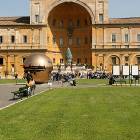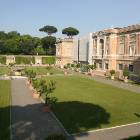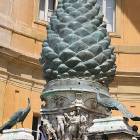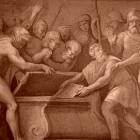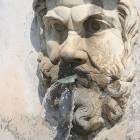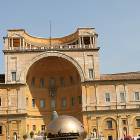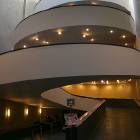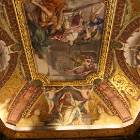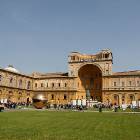The Belvedere Palace in the Vatican
The Papal residence is not a palace in the traditional understanding of the term, but rather a collection of villas, palaces and other interconnecting buildings, constructed in different centuries. The oldest, the Belvedere, dates from 1484. At that time it was the first major villa built in Rome not out of necessity, but for the enjoyment of someone, which speaks of the state of decay the city saw after the fall of the empire.
The ambitious Pope Julius II started amazing projects, using the greatest Renaissance artists. The architecture of the Vatican was forever transformed by the vision of Donato Bramante, who made the plans for St Peter’s Basilica and for the palace found next to it. Mons Vaticanus (the Roman hill on which the smallest state in the world is found) had to be transformed itself with terraces that offered better view, better usage of the space and design opportunities. The spaces offered by the terraces, on which the breeze of Tiber blew, was completed by vast inner courtyards. These were used for public ceremonies and spectacles, but were dramatically reduced by the constructions built later on.
The most exuberant of the Medici popes, Leon X, brought the idea of luxury to new heights. In addition to scandalous banquets, he even had his own zoo garden, which included a white elephant. The courtyard that today tourists use for a break in the middle of their long and overwhelming tour through the vast Vatican Museum was once used for parading the elephant or for other games and ceremonies.
Some of the exhibits determined the addition of new building wings, as was the case with the large statue of Apollo and the statuary group of Laocoon, collected by Julius II. Most of the Apostolic Palace is now occupied by the enormous collections of antique and renaissance sculptures, by the paintings in the art collection, and by the Vatican Library. Other sections of the papal complex were forever marked by the genius of the artists that decorated them, as was the case with the Raphael Rooms or with Michelangelo’s Sistine Chapel.
The great yard of the palace also hosts some important sculptures. There is the statue of Apollo, moved to a marginal position by a successor of Julius II, who didn’t accept the artistic taste of some popes for pagan deities. Than, there is one of the oldest sculptures in Rome: a giant pine-cone sculpted in bronze, with two beautiful peacocks on its sides. It was probably a fountain but also a fertility symbol and stood in front of the temple of Isis. In occultism, the pinecone is a symbol of the interior eye, of enlightenment. Modern occultists have associated this holder of the seeds of pine tree with a gland in the brain, shaped just like a pinecone, found at the upper end of the spine, producing serotonin and regulating sleep. It’s unclear weather this was adopted by he Romans simply because the pine is the local tree along the Tiber or with such speculative significance, or whether such symbolism was perpetuated at some level of the Catholic Church hierarchy. This pine cone gave the name of this courtyard – Cortile della Pigna.
Another mysterious sculpture is a golden sphere with cracks and another sphere and geometric shapes inside. It is the work of a XX century artist Arnaldo Pomodoro, and is named The Sphere within Sphere (Sfera con sfera). A replica of this sculpture of a cracked globe is also placed in front of the United Nations headquarters in New York, raising further speculations about a “new world order” hidden significance.
- Home Page
start page - Architecture
landmark buildings - Sacred architecture
places of worship - Nature
landscape photography - Concert
performing artists - Christmas
Santa Claus pictures
- Jooble
jobs for photographers - Escape
an out of control blog - Merry Christmas
The best organizer of Christmas parties - Astro photo
Eclipse hunting and astrological photography

